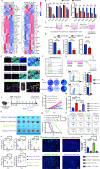Evasion of immunosurveillance by the upregulation of Siglec15 in bladder cancer
- PMID: 39609852
- PMCID: PMC11606300
- DOI: 10.1186/s13045-024-01638-2
Evasion of immunosurveillance by the upregulation of Siglec15 in bladder cancer
Abstract
Immunotherapy resistance in bladder cancer (BLCA) is associated with elevated levels of sialic acid-binding immunoglobulin-like lectin (Siglec15). This protein plays a crucial role in fostering a noninflammatory tumor microenvironment (TME), which is conducive to cancer progression. Our study confirmed that the overexpression of Siglec15 led to a reduction in CD8+ T cell infiltration. This effect was mediated by the downregulation of pro-inflammatory cytokines and chemokines, which in turn exacerbated BLCA malignancy. Furthermore, Siglec15 inhibited the cytotoxicity of effector T cell, contributing to immune evasion. An in vivo study demonstrated that Siglec15 overexpression induced a non-inflammatory TME and promoted resistance to immunotherapy. These findings highlight Siglec15 as a potential therapeutic target for BLCA. By modulating inflammation in the TME and CD8+ T cell function, targeting Siglec15 may offer a novel strategy for overcoming immunotherapy resistance and improving patient outcomes.
Keywords: Bladder cancer; Immunotherapy; Noninflamed tumor microenvironment; Siglec15.
© 2024. The Author(s).
Conflict of interest statement
Declarations. Ethics approval and consent to participate: This study and all experiments on mice were reviewed and approved by the Ethics Committees (ethical number: 202112241). The authors are accountable for all aspects of the work in ensuring that questions related to the accuracy or integrity of any part of the work are appropriately investigated and resolved. Consent for publication: All data presented in this publication are de-identifed and do not contain individual information. Competing interests: The authors declare no competing interests.
Figures

References
-
- Siegel RL, Giaquinto AN, Jemal A. Cancer statistics, 2024. CA Cancer J Clin. 2024;74(1). - PubMed
-
- Powles T, Sridhar SS, Loriot Y, Bellmunt J, Mu XJ, Ching KA, Pu J, Sternberg CN, Petrylak DP, Tambaro R, Dourthe LM. Avelumab maintenance in advanced urothelial carcinoma: biomarker analysis of the phase 3 JAVELIN Bladder 100 trial. Nat Med. 2021;27(12):2200–11. - PubMed
-
- Sadeghi S, Quinn D, Dorff T, Pal S, Groshen S, Tsao-Wei D, Parikh R, Devitt M, Parikh M, Jackovich A. Ruel N EphrinB2 inhibition and pembrolizumab in metastatic urothelial carcinoma. J Clin Oncol. 2022;41(3):640–50. - PubMed
Publication types
MeSH terms
Substances
Grants and funding
LinkOut - more resources
Full Text Sources
Medical
Research Materials

